 |
 |
 |
|
|
|
|
Firearms Technical Trivia, April 2001:
 |
 |
 |
4. TEST FIRE AND MUZZLE DEVICE SELECTION
As each rifle was completed, we took it to the range to test fire. Each gun was to fire five complete magazines (100 rounds), and to be tested for function, reliability, accuracy, set-back, and recoil.
Function
The gas port was opened up all the
way, a loaded magazine inserted and the rifle charged. After each
shot, the rifle was inspected to determine if it had cycled properly.
Each time the rifle failed to cycle properly, we removed the magazine,
cycled the mechanism to eject the spent casing, and closed the gas port
adjustment ring one click. The rifle was then recharged, and fired
again. Once a setting was found where the rifle would function consistently
and reliably, an entire twenty round magazine was cycled through to verify
function.
| Interestingly, the main culprit in reliability issues turned out to be the gas tube/gas piston interaction. In the R1 kit, the the tube bore signs of having been removed from the rifle while the gas tube retaining pin was still in place. Consequently, the threads at the front end were compressed. While the inside diameter didn't look to have been affected, looks can be deceiving. Indeed, the gun seemed to function with either the original gas piston or an Entreprise Arms manufactured replacement piston. However, a DS Arms replacement piston wouldn't even fit into the tube. A quick set of measurements told us why: |
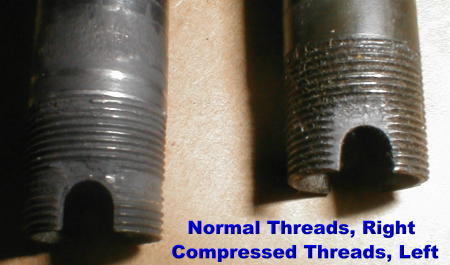 |
|
|
|
| Entreprise No. 1 |
|
| Entreprise No. 2 |
|
| Entreprise No. 3 |
|
| Original R1 Piston |
|
| Original Imbel Piston No. 1 |
|
| Original Imbel Piston No. 2 |
|
| DS Arms Piston |
|
| Original StG58 Piston |
|
As can be seen, the piston head sizes had a dimensional variance of .004". Evidently, this was enough to cause the larger pistons to bind in the tube with compressed threads. All the pistons moved freely in both new tubes and tubes that had not had their threads compressed.
Inital testing of the Imbel receivered R1 rifle was done using a gas tube with a compressed end. The compression's added resistance to the piston's travel required the gas setting to be set almost fully closed, on 2. We replaced the tube with another with an uncompressed end, and reliable function was had with the gas setting on 3.5 The remaining rifles functioned well, with gas system settings varying from 2 to 4. (Editor's note: While this is more than adequate for range work, ideally a clean rifle with parts in good condition should function with the gas system between 5 and 7. The gas system can be tuned by opening up the gas port by ten to fifteen thousandths of an inch to ensure more vigorous function, but that is beyond the scope of this article.)
Reliability
The rifles were tested with a variety
of military 7.62mm NATO ball ammunition, as well as a variety of metric
magazines. Ammunition included Portuguese FNM made in 1983, British
Radway Green made in 1992, and German DAG ammunition, also of early 1990's
manufacture. Magazines included those of Israeli, Austrian, South
African, and Belgian manufacture. Each rifle was fired one hundred
times, including those rounds used to determine the optimal gas system
settings. Stoppages or malfunctions were only counted after the proper
gas system setting and components had been determined. Results are
noted below:
|
|
|
|
|
|
|
|
|
|
|
|
|
|
|
|
Accuracy
Each rifle was fired for relative
accuracy at fifty yards at the NRA range in Fairfax, Virginia using the
German DAG ammunition. Best group sizes, extrapolated to minutes
of angle (MOA), for each rifle are shown below:
|
|
|
|
|
|
|
|
|
|
|
|
Set Back
Upon initial firing, there is a
possibility that the locking shoulder will settle a little further into
its recess in the receiver, causing a change in the headspace dimension.
Consequently it is imperative that headspace be rechecked after the gun
is test fired. Extreme changes, measured in several or more thousandths
of an inch, may indicate a problem with the receiver's metallurgy.
Our headspace recheck results are noted below:
|
|
|
|
|
|
|
|
|
|
|
|
Recoil and
Muzzle Brake
All other things being equal, recoil
sensation should be equivalent between FAL's, and for that matter, other
7.62mm NATO self loading rifles in the same weight class. This is
most emphatically not the case in the world of FAL parts kit guns.
There is a wide selection of muzzle brakes available to the intrepid FAL
builder. Some of them are more effective at reducing recoil, some
less so, and some serve little purpose other than to intensify recoil.
We chose two different brake styles to test; the Entreprise "Zero Climb"
muzzle brake, and John Glover's recreation of the original Belgian short
brake found on military FAL's.
|
|
|
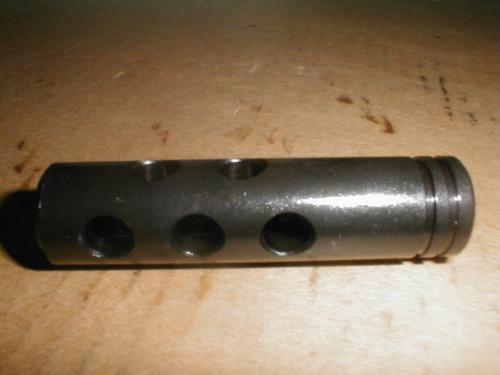 |
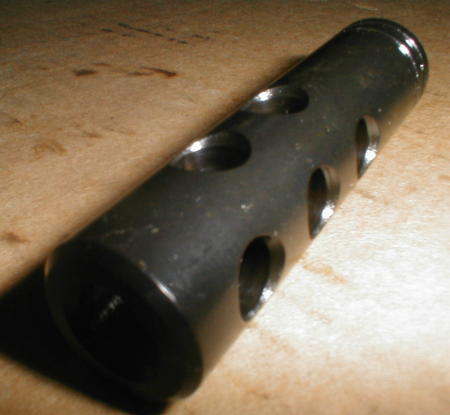 |
| THE
PRODUCT: The Entreprise Arms "Zero Climb" muzzle brake is
the same one that comes affixed to Entreprise's FAL rifle offerings.
Made on CNC machinery from a solid billet of 4140 steel, it is reminiscent
of an artillery piece's muzzle device. There are three large gas
escape ports on either side of the brake and two on top. The device
uses the same reverse thread found on FAL muzzles and screws on easily.
It is not indexed. As a result, it must be indexed using washers,
like an M16 muzzle device, or simply backed off from tight until it indexes
properly and then silver soldered in place. This brake has been evaluated
and approved by the BATF as "not a flash suppressor." It is too small
in diameter to mount the FAL bayonet or a rifle grenade and lacks the locking
notch in the rear.
THE PRICE: One of the least expensive, the Entreprise Zero-Climb Brake costs $19.95 plus shipping. EFFECTIVENESS: Entreprise advertises the Zero-Climb Brake as eliminating 40% of felt recoil and 100% of muzzle rise. After firing a rifle with the Entreprise brake, without any muzzle device, and the other deviced noted in this article, we're inclined to agree. This was, by far, the most effective brake that we tested. Shooting a FAL with this brake on is downright pleasant. If it's function you're after, this is the brake of choice. If it's authenticity, well, it falls a little short as it looks nothing like any brake that ever appeared on any FAL as used by any army. But then, if authenticity was your primary reason for owning an FAL, you'd have ponied up the $2K - $3K for an honest to goodness pre-ban Belgian 50.00 and you wouldn't be reading this now! REMARKS: The brake's construction takes full advantage of the capabilities offered by CNC milling. The surface is finished to an attractive satin, and then nicely blued. All the ports are attractively chamfered, and the circumference of the bullet exit port is beveled. The two rings milled at the rear of the brake are a nice touch, but dont' really serve any useful purpose. |
|
|
|
||
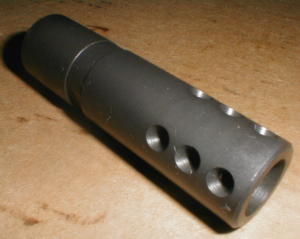 |
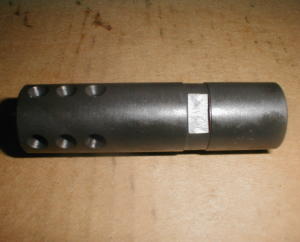 |
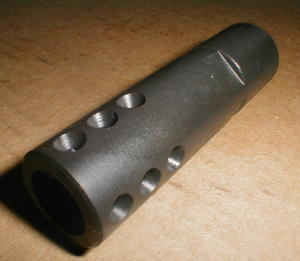 |
| THE
PRODUCT: Made in a small machine shop in Charlotte, North
Carolina, John Glover's brake is a faithful recreation of the original
"Belgian short" muzzle brake found on the majority of metric FAL's.
Machined from 8620, 4140 or 1018 steel tubing, the brake has several features
that make it of particular interest to the intrepid FAL builder.
To begin with, while it faithfully maintains the general size and contouring
of the original (down to the installation flats!), it is .020" larger in
diameter. This means that neither an original bayonet nor rifle grenade
will fit onto the brake. Additionally, the bayonet locking notch
on the rear has been omitted. As on the original, the brake has four
rows of three ports bored at ninety degree intervals. However, the
holes on Glover's brake are bored at a ninety degree angle to the bore,
as opposed to the forward angled holes on the original, and the internal
expansion chamber is larger in diameter. Both of these design attributes
contribute to the Glover brake being more effective at reducing recoil
than the original. The brake can be had in the white or parkerized
(shown), and upon request (for no additional charge) one of the flats can
be stamped with a small "US" to indicate domestic manufacture. As
an additional bonus, all three of the Glover brakes we tried were pre-indexed,
and came within a degree of true on four different barrels.
THE PRICE: $25.00 plus $3.00 shipping. EFFECTIVENESS: While not as effective at eliminating recoil as the Zero-Climb brake offered by Entreprise, this brake is still very effective, and the rifle fitted with this brake was quite pleasant to fire - significantly more so than an unbraked rifle. Additionally, the brake bears a very close resemblance to the original, which makes rifles so equipped aesthetically pleasing. REMARKS: The brake is very nicely machined and finished. For our money it is as close as one can come to having an authentic Belgian short one's rifle. (There is some effort being made to alter original Belgian shorts to bring them into regulatory compliance, but the jury is still out.) All the ports are nicely chamfered, and the circumference of the bullet exit port is beveled. |
||
|
|
||
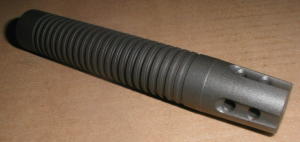 |
|
|
| THE
PRODUCT: The Austrian incarnation of the FAL, known as the
StG58 was distinguished by a very long, thick flash suppressor with a distinctive
ribbed appearance. This flash suppressor, named after its inventor,
Major Stoller had a distinctive ribbed appearance punctuated by four short
prongs. The Stoller suppressor could also be used to cut barbed wire;
a strand of wire was caught in two of the openings between the prongs,
the rifle slighly twisted to hold the strand in place, and a regular ball
cartridge discharged. Despite its obvious uses in the livestock control,
fencing, and security industries, the Stoller suppressor is prohibited
from being installed on post-ban rifles. DS Arms has faithfully recreated
the look of Stoller's design with a muzzle brake that uses sculpted metal
and ports in the front of the brake instead of individual prongs (and is
therefore a "muzzle brake" instead of a "flash suppressor."
CNC Machined from 4140 or 1060 steel bar stock , the brake is .0390"
larger in diameter than the original, and wil not accept the 22mm rifle
grenades. The gas ports are bored at a ninety degree angle
to the bore.
THE PRICE: $18.95 plus shipping EFFECTIVENESS: This brake is substantially less effective than the Entreprise Zero-Climb brake, but still more effective than an unbraked gun. Additionally, the brake bears a very close resemblance to the original, which makes rifles so equipped aesthetically pleasing. REMARKS: The brake is very nicely machined and finished. Like ther Glover brake, it is as close as one can come to having an original on a post-ban rifle. All the ports are nicely chamfered, and the circumference of the bullet exit port is beveled. |
||